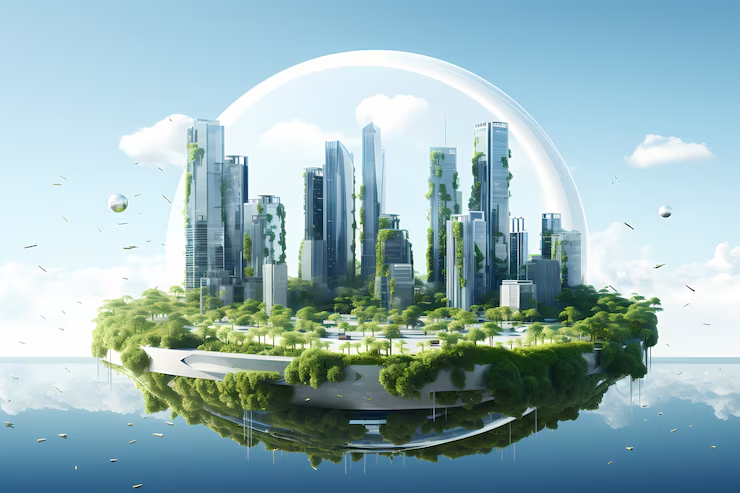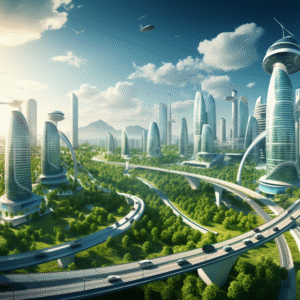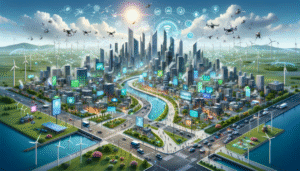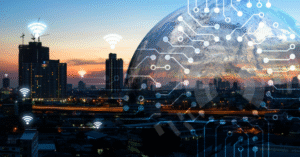🏙️ 5G + AI + IoT: What the Smart Cities of 2030 Will Look Like
Introduction
Imagine a city where traffic jams are nonexistent, energy is used with pinpoint efficiency, garbage bins request pickups, and emergency services arrive before you even dial 911. This is not science fiction—it’s the future of smart cities in 2030, powered by a potent combination of 5G, Artificial Intelligence (AI), and the Internet of Things (IoT).
In this article, we’ll explore how these three technologies are converging to transform urban life. From intelligent infrastructure and predictive services to sustainable energy and security, here’s what our cities will look like by 2030.
🌐 The Building Blocks of Smart Cities: 5G + AI + IoT
📶 5G: The Backbone of Real-Time Connectivity
The rollout of 5G networks provides ultra-fast, low-latency wireless communication—essential for real-time data transmission between billions of connected devices. With speeds up to 100 times faster than 4G and latency as low as 1 millisecond, 5G enables the real-time responsiveness smart cities require.
🤖 Artificial Intelligence: The Brain of the City
AI systems analyze massive amounts of data generated by IoT sensors, cameras, and devices. These systems learn from patterns, predict outcomes, automate decision-making, and optimize city functions—like traffic management, public safety, and utility distribution.
📡 Internet of Things (IoT): The Nervous System
IoT includes everything from smart streetlights to water meters, waste bins, and autonomous vehicles. In 2030, cities will host billions of IoT sensors embedded into roads, buildings, bridges, and transportation systems—all collecting data for real-time decision-making.
🛣️ Smart Transportation & Mobility
One of the most dramatic changes in smart cities will be mobility.
🚗 Autonomous Vehicles
By 2030, self-driving cars and public transport will dominate urban transportation. Thanks to 5G-powered V2X (Vehicle-to-Everything) communication, vehicles will interact with traffic lights, pedestrian signals, and other cars to avoid accidents and optimize routes.
-
AI Use Case: Google’s Waymo and Tesla’s Full Self-Driving (FSD) systems use deep learning models to navigate complex city environments.
-
IoT Integration: Smart road sensors detect potholes and alert maintenance teams in real-time.
🚦 Intelligent Traffic Systems
Cities will use AI-driven traffic management platforms to reduce congestion by rerouting traffic dynamically. Combined with real-time data from IoT traffic lights and surveillance, the system will ensure a smoother, safer commute.
-
Example: Singapore’s Intelligent Transport System already uses AI + IoT for dynamic traffic light adjustments.
🏙️ Smart Infrastructure & Urban Planning
🏗️ Digital Twins
Digital twins—virtual replicas of physical infrastructure—will be widely used in 2030 to simulate changes before implementation. AI can analyze the twin to predict how buildings, roads, or systems behave under stress or population growth.
-
Example: Cities like Shanghai and Helsinki are already using digital twins for urban planning.
🛠️ Predictive Maintenance
Sensors in roads, bridges, and buildings will continuously monitor stress, cracks, or vibration. AI will analyze this to predict failures before they happen, reducing downtime and increasing public safety.
⚡ Smart Energy and Sustainability
☀️ Energy Optimization
IoT-enabled smart grids will automatically balance energy demand, store excess solar energy, and adjust usage patterns. AI algorithms will forecast power consumption and control appliances accordingly.
-
5G’s Role: Enables millions of sensors in real-time communication with utility companies.
-
Use Case: Smart thermostats, lights, and appliances that self-regulate to save energy.
🌱 Carbon Emission Monitoring
AI will measure city-wide carbon emissions using IoT sensors on vehicles, factories, and buildings. These systems can then suggest emission-reducing policies or dynamic traffic management to lower pollutants.
🗑️ Waste Management and Cleanliness
🧹 Smart Waste Collection
Waste bins embedded with IoT sensors will notify waste trucks when full, optimizing collection routes and minimizing unnecessary trips.
-
Use Case: BigBelly smart waste bins already doing this in New York City.
💧 Water Conservation
Leakage-detecting IoT sensors will identify pipe bursts or overuse. AI will prioritize fixes based on severity and historical data.
🛡️ Public Safety and Surveillance
🧠 AI-Powered Surveillance
AI-driven CCTV systems can recognize faces, detect abnormal behavior (like loitering or fights), and alert authorities in real-time.
-
Example: China’s cities are already testing facial recognition surveillance integrated with social credit systems.
-
Privacy Challenge: Cities will need to balance safety with data privacy and civil liberties.
🆘 Predictive Policing
Using crime data, AI systems can predict where crimes are likely to occur and allocate police resources accordingly.
-
Example: Chicago’s “Strategic Subject List” once used predictive algorithms to flag individuals at high risk of violence.
🏥 Smart Healthcare in Cities
🏠 Remote Monitoring
Patients with chronic conditions can wear IoT health devices that transmit vitals to doctors in real time. AI will analyze the data for early signs of deterioration.
-
5G Advantage: Enables real-time remote surgery or telemedicine with minimal lag.
🚑 Smart Ambulances
Connected ambulances will share patient vitals en route and receive traffic priority via AI-controlled traffic signals.
🧠 AI for Citizen Engagement
📲 Personalized City Services
AI chatbots and voice assistants will act as digital city guides, helping residents find jobs, report potholes, or apply for permits.
-
Use Case: Dubai’s “Rashid” AI assistant helps with visa, education, and healthcare queries.
🗳️ E-Governance and Participation
Blockchain + AI + IoT will make digital voting secure and accessible. Citizens can participate in polls, city planning feedback, or budget decisions via their smartphones.
🔐 Cybersecurity and Ethics
The downside to hyper-connected cities is vulnerability. Smart cities will be attractive targets for hackers.
🔒 AI in Cybersecurity
AI will continuously scan for threats, monitor unusual behavior, and respond to security breaches in milliseconds.
-
5G Risk: Larger attack surface due to more connected devices.
-
Solution: Edge AI + Quantum encryption for faster and more secure processing.
🌍 Global Examples Leading Toward 2030
🇸🇬 Singapore
Singapore is a model smart city with:
-
Smart traffic cameras
-
AI-based flood monitoring
-
IoT-enabled eldercare
🇰🇷 Seoul
Seoul uses AI and IoT for real-time public transport info, air pollution management, and smart waste systems.
🇪🇪 Estonia
Estonia has digitized 99% of its government services—marriages, taxes, healthcare—all accessible online.
🚀 What Will 2030 Smart Cities Look Like?
By 2030, expect:
-
Driverless public transport fleets
-
AI-powered emergency response drones
-
Zero-emissions energy grids
-
Real-time pollution alerts via wearables
-
Citizen digital twins (your city profile)
These cities won’t just be efficient—they’ll be intelligent ecosystems designed to enhance quality of life for everyone.
Urban Resilience & Disaster Preparedness
Smart cities will be engineered not only for routine efficiency but also to withstand crises.
Early Warning Systems
-
IoT Sensors: Detect seismic activity, flooding, or air toxins—triggering automated alerts.
-
AI Algorithms: Predict weather events, landslides, or disease outbreaks using streams of sensor data.
-
5G Connectivity: Enables instantaneous communication with residents and rescue teams.
Autonomous Response Systems
-
Drones & Robots: Deployed autonomously to monitor disaster zones, deliver aid, or assess damage.
-
AI-led Medical Triage: Prioritize cases remotely to manage hospital overload during emergencies.
-
Smart Shelters: Modular, energy-efficient safe zones that track occupancy, air quality, and stress signals in crowds.
Smart Education Ecosystems
Connected Campus Networks
In 2030, schools and universities will integrate with citywide IoT grids:
-
Smart Classrooms: AI tutors monitor student progress in real time and adapt lessons accordingly.
-
Automated Scheduling: Campus shuttles and facilities optimized using predictive demand.
-
Indoor Air Quality: Sensors regulate ventilation for optimal cognitive performance.
Public Learning Spaces
-
AI Kiosks: Spread around the city offering educational micro-lessons and skill modules.
-
Virtual Libraries: AR/VR-enabled zones let students access simulated environments—from historical sites to labs.
Data Governance & Platform Governance
Decentralized City Platforms
Smart cities will rely on federated data platforms, where sensors, agencies, and residents share data securely while retaining control.
-
Blockchain-backed audits ensure transparency.
-
Consent-based data marketplaces allow citizens to opt into monetization of non-sensitive data like air quality or traffic flow.
Algorithmic Oversight Councils
Cities will establish independent ethics boards that audit AI algorithms for bias, safety, and public health impact—ensuring AI decisions remain accountable.
Inclusive Planning & Equity
Bridging the Digital Divide
Smart cities must ensure:
-
Affordable 5G access in underserved neighbourhoods.
-
Low-cost smart devices preloaded with educational and health services.
-
Community hubs where citizens can access digital services and training.
Participatory Urban Design
AI-driven platforms will let residents propose neighborhood changes—like new bike lanes or green spaces—using VR simulations before implementation.
Cultural Preservation & Smart Heritage
Digital Heritage Layers
-
IoT-enabled historic sites offer AR guided tours.
-
Sensors monitor structural degradation in real time to aid preservation.
Interactive Culture Hubs
-
AI-powered installations react to citizen engagement.
-
AI DJs or art bots collaborate with local creators to produce public experiences.
Economic Strategies in Smart Ecosystems
AI-Driven Commerce
-
Smart marketplaces personalize discounts, promote local SMEs, and reduce waste with predictive inventories.
-
Dynamic pricing in public transport and events manages demand.
Startup Accelerators & AI Pilots
Cities will host innovation zones where:
-
Developers test urban AI applications on controlled IoT testbeds.
-
City-sponsored grants fund AI projects solving local problems like flooding or traffic bottlenecks.
Green Mobility & Transportation
Mobility-as-a-Service (MaaS)
Public and private transport options (autonomous buses, e‑scooters, ride-sharing) integrate into one app—AI optimizes routes, charges, and wait times.
Smart Roads & Energy Harvesting
-
Road surfaces embedded with kinetic energy harvesters power streetlights or sensors.
-
AI applications direct epidemic-safe pedestrian flow to reduce crowding.
The Human Dimension of Smart Cities
Reimagining Public Spaces
AI-driven light, sound, and environmental control systems will adjust dynamically—enhancing comfort, safety, and inclusivity in parks, bus stops, and plazas.
Emotional Well‑Being Monitoring
From wristbands to clothing, wearable sensors might feed anonymized mood and stress data into AI to alert mental health services when citizens need support—prioritizing human-centered care in city planning.
Edge AI and Hybrid Cloud Models
Edge AI
Many smart city functions require ultra‑low latency—like traffic lights, autonomous vehicles, or public safety systems. To ensure real-time responses:
-
AI inference will shift toward on‑device or edge computation.
-
Edge servers will process data locally, reducing reliance on cloud and protecting privacy.
Hybrid Architecture
Smart cities will use a hybrid cloud-edge architecture which balances:
-
Speed (via edge servers and 5G)
-
Scalability (centralized cloud for analytics)
-
Resilience (redundant systems to handle failures)
Global Best Practices for 2030
Singapore’s Live Urban Dashboard
An integrated AI dashboard displays real-time city metrics—air quality, energy usage, traffic flow—while offering action insights to both administrators and residents.
Barcelona’s Urban OS
Barcelona runs Open‑source Urban Operating Systems integrating sensors, public feedback, and transport data—driving transparency and modular growth.
Dubai Paperless Initiatives
Entire municipal services are automated with smart portals and AI agents—making citizen interaction efficient and digitally inclusive.
Risks and Red Lines to Watch
AI overreach & social control
Cities must avoid turning into “surveillance states”. Open audits, consent policies, and digital rights charters will be essential.
Vendor lock-in
Relying on proprietary IoT systems or closed AI platforms could limit flexibility. Cities should adopt open standards to ensure interoperability.
Tech inequality
If half the city lacks access to smart services, equity is compromised. Smart city planning must prioritize inclusivity from day one.
Visionary Scenario: A Day in a 2030 Smart City
-
Morning commute: Autonomous shuttles coordinate with traffic sensors to minimize delays.
-
At work: Smart building systems adjust lighting and ventilation based on occupancy.
-
Lunch: Your phone suggests a recipe using local food consumption trends and instant delivery via drone.
-
Afternoon: Pollution alerts reroute your jog through greener paths.
-
Evening: AI-curated public performance in a smart plaza reacts to crowd mood and weather.
Every part of the day interacts seamlessly with 5G latency, AI intelligence, and IoT awareness.
Conclusion
The smart cities of 2030 represent a bold vision powered by 5G, AI, and IoT. These cities promise to be efficient, sustainable, inclusive, and secure—but only if technology is harnessed ethically and equitably.
The path to smart city maturity demands human-centric design, intergenerational accessibility, robust governance, and transparent data practices.
Ultimately, smart cities are not about technology—but about maximizing human well‑being in harmony with urban systems.
But one thing is clear—the future of urban living is smarter, faster, cleaner, and more connected than ever before.
https://bitsofall.com/top-5-ai-devices-to-use-in-2025-that-are-revolutionizing-daily-life/
https://bitsofall.com/future-of-smartphones-ai-powered-everything-2026/






